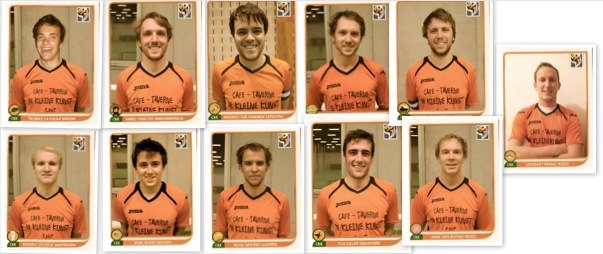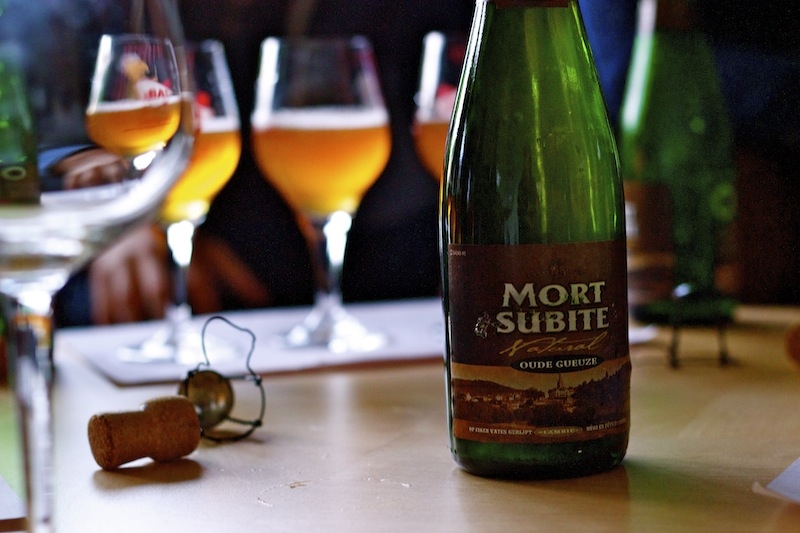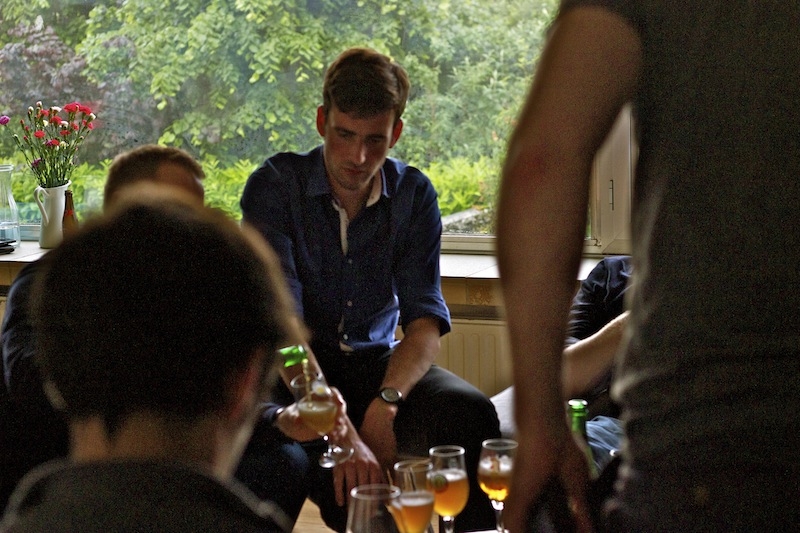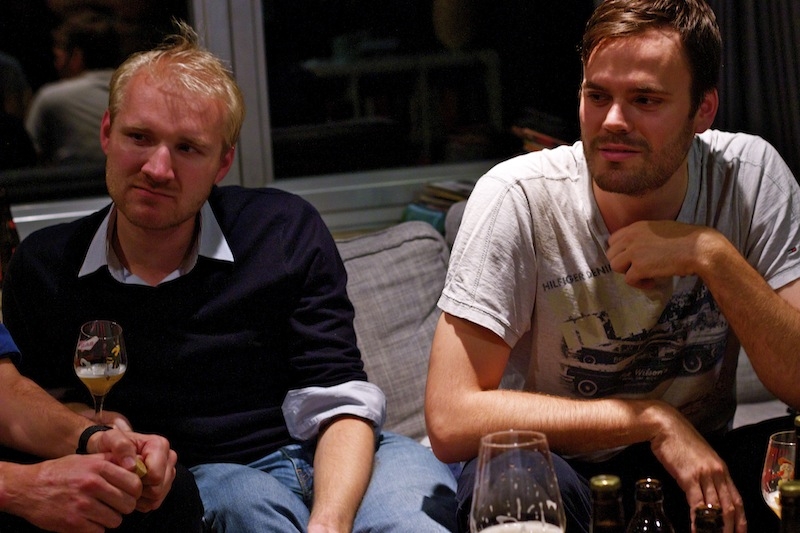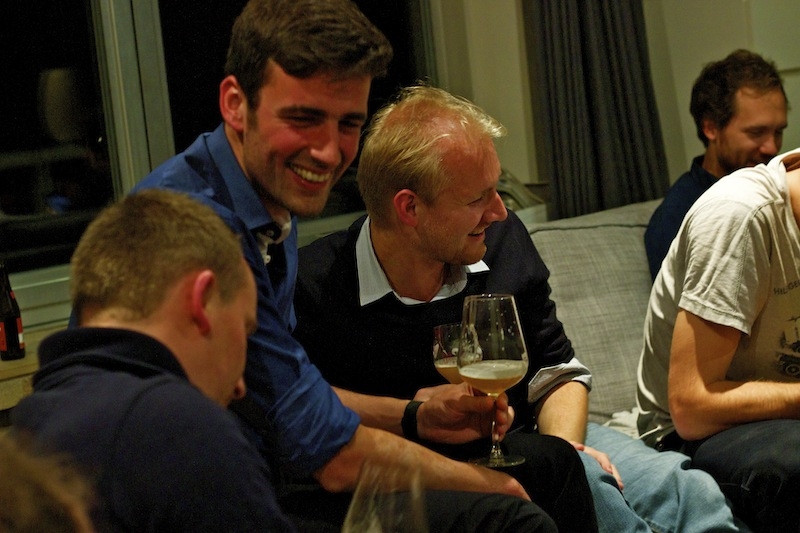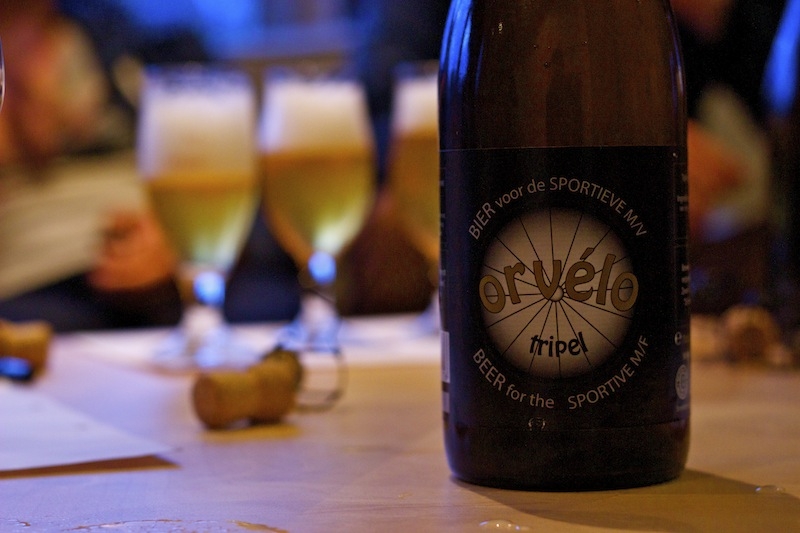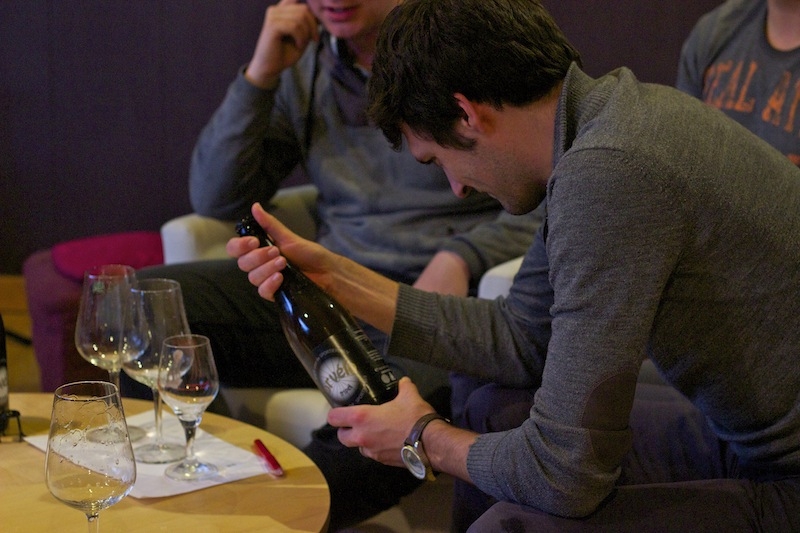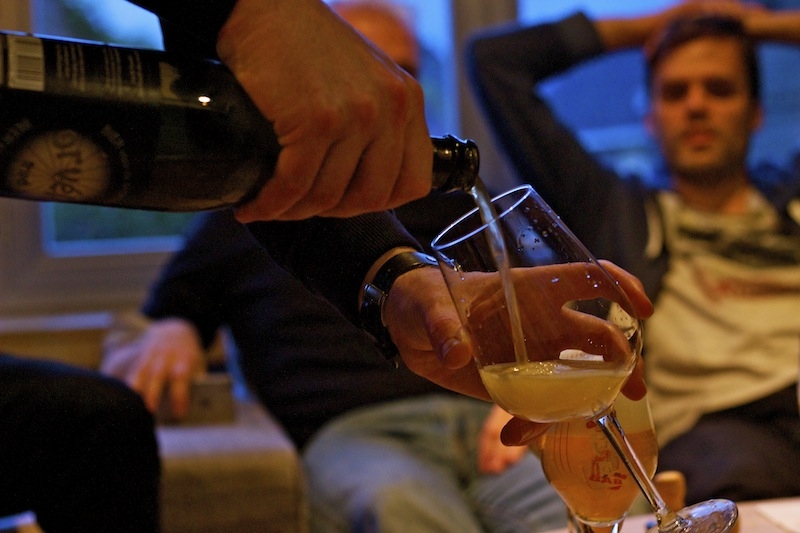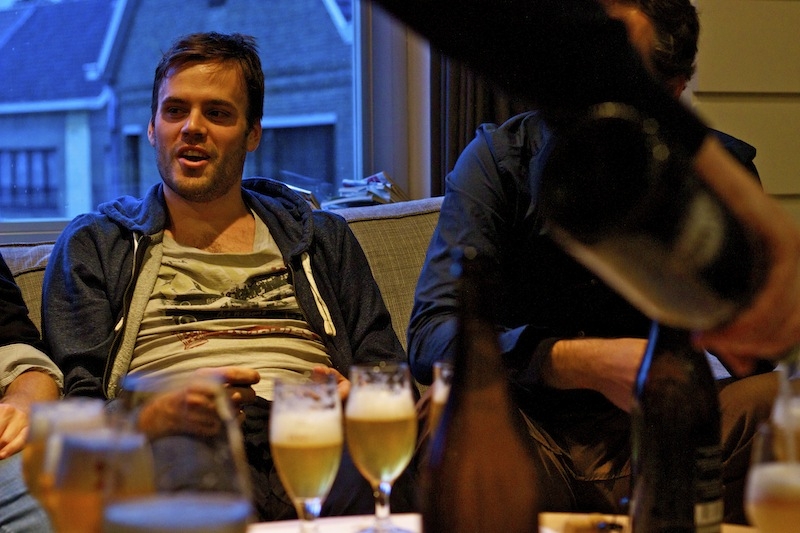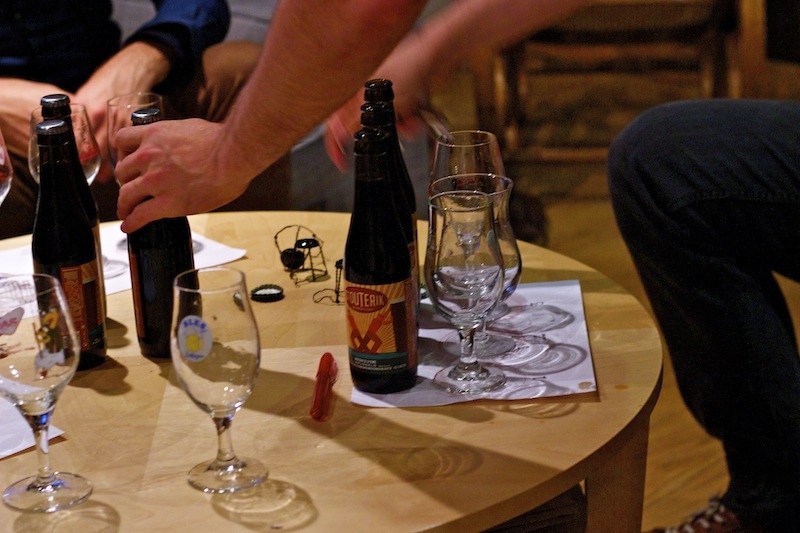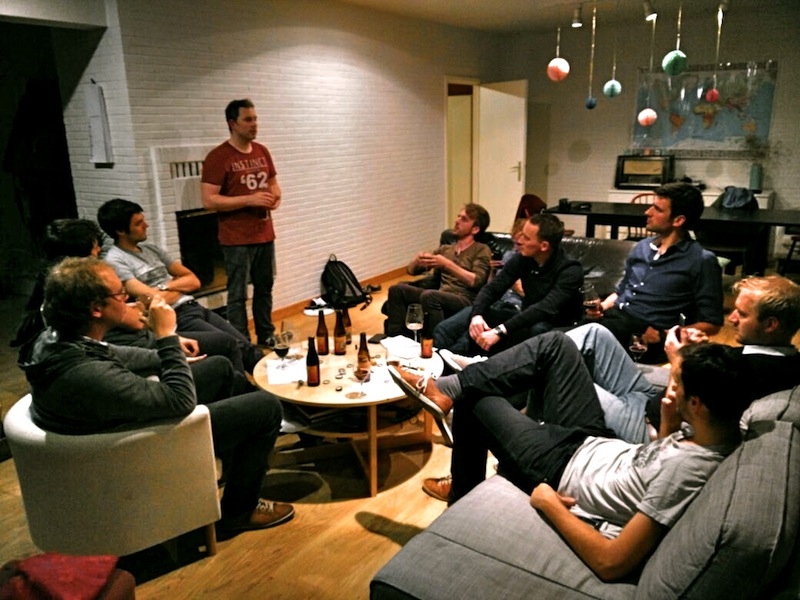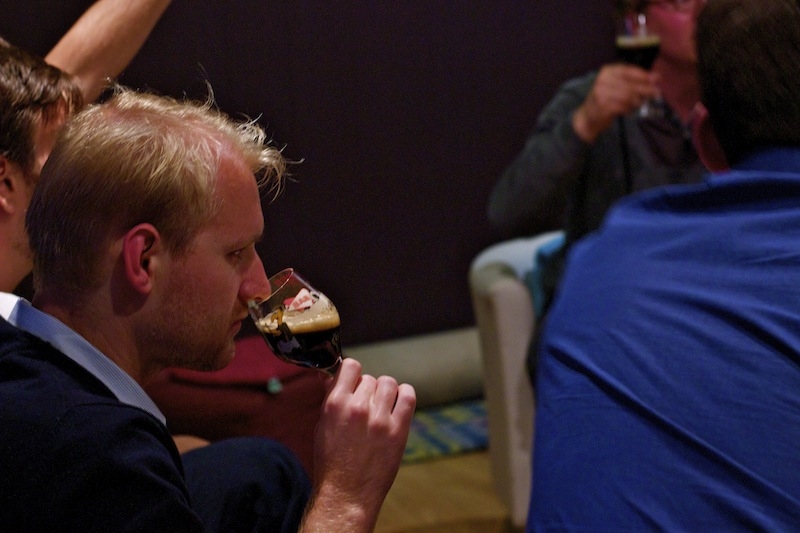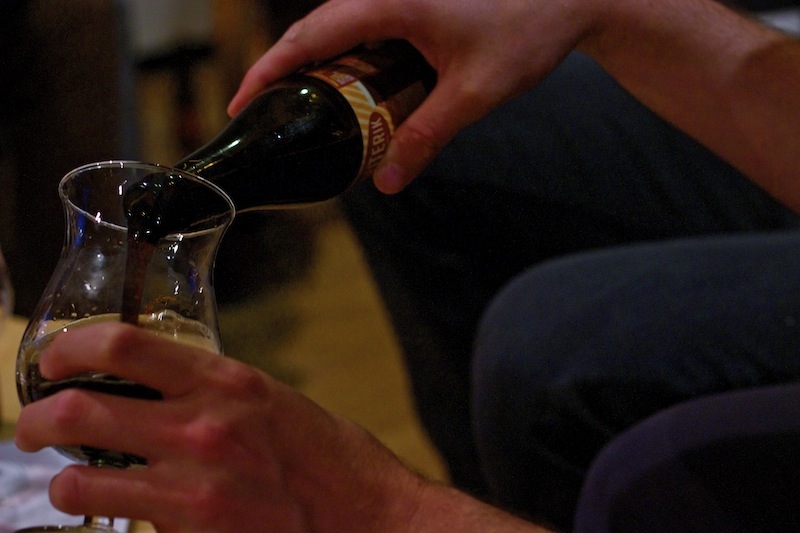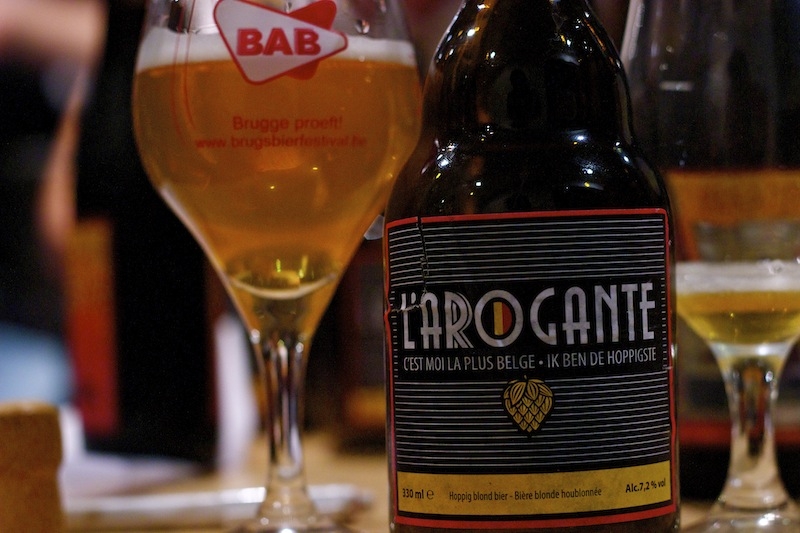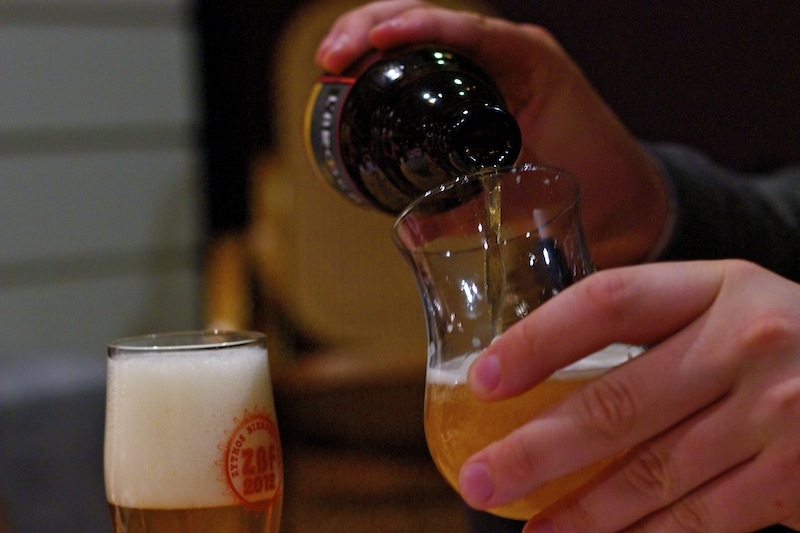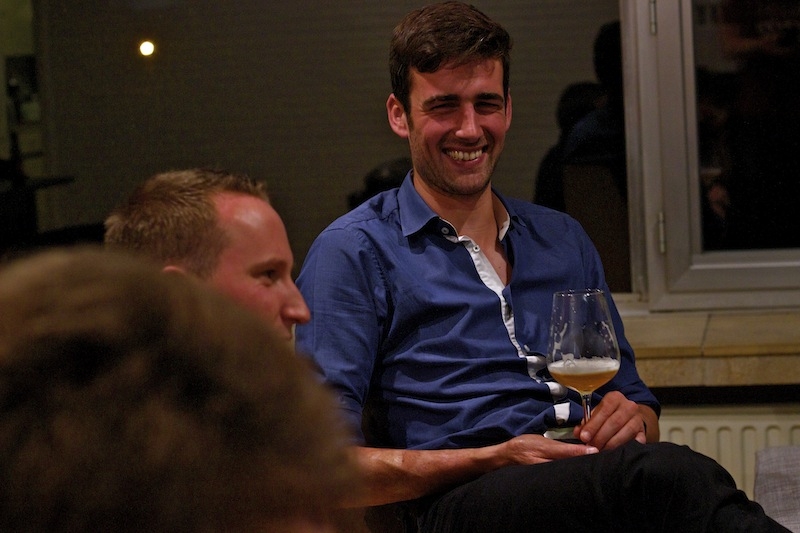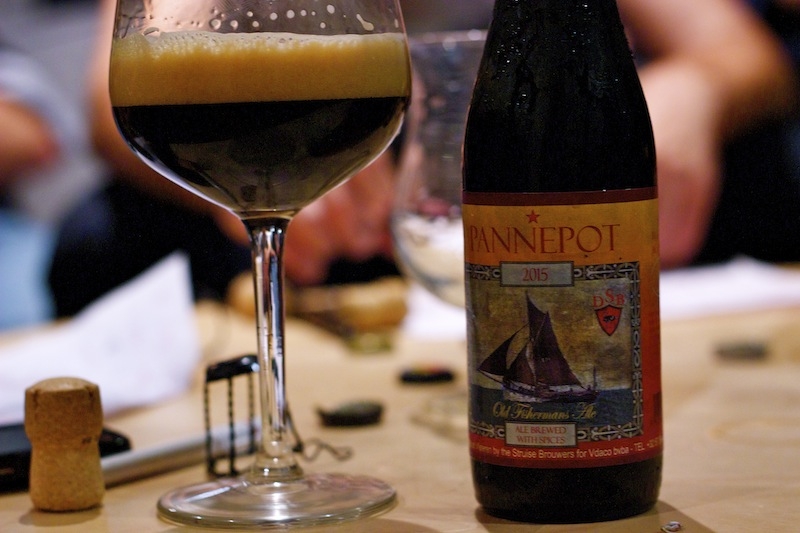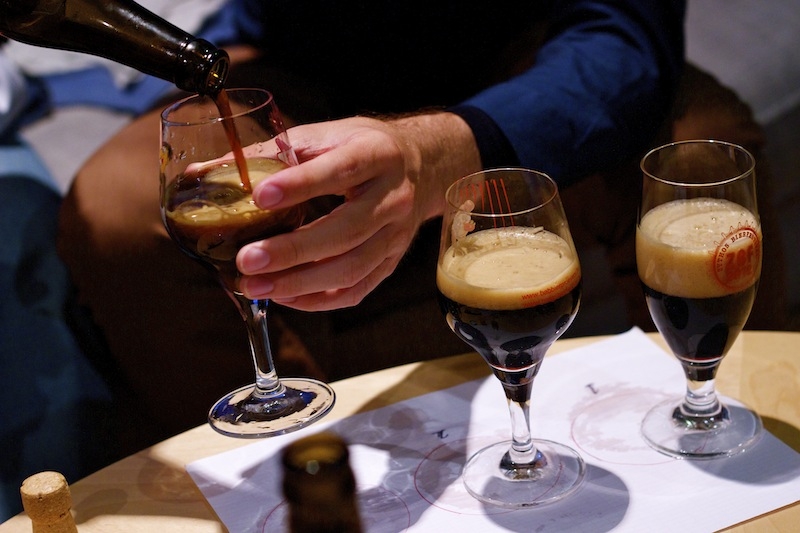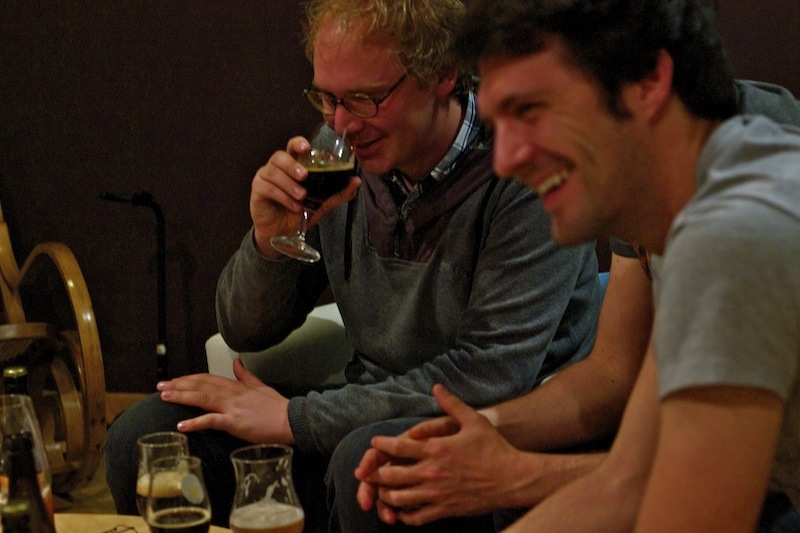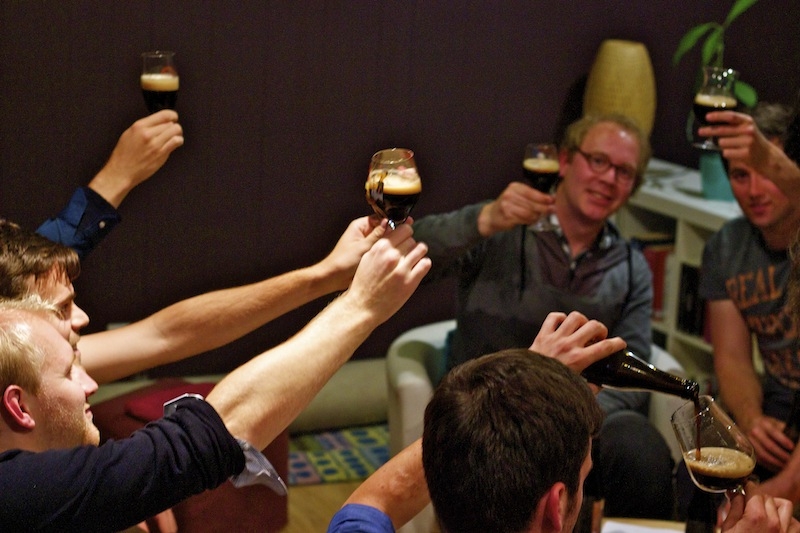It’s perhaps fitting in the aftermath of the Ghent football team, KAA Gent, winning the Belgian Pro League for the first time in their 115 year history, that I deliver a beer tasting to a local football team based in Ghent.
The beer tasting this evening is a commodity in a charity auction which took place at the beginning of the year in which two of our close friends – Soph and Andries – invited participants to offer goods and services to benefit the disaster recovery organisation, All Hands, with whom they had volunteered in the Philippines the previous year.
Our lots in the charity auction: a tray of chocolate brownies; and a beer tasting in a theme of your choice. pic.twitter.com/qNaUr3yq8n
— Belgian Smaak (@belgiansmaak) January 17, 2015
Some people offered bike maintenance services. Others auctioned off a house cleaning service. Elisa’s homemade chocolate brownies sparked an aggressive bidding war and disappeared before the night was over. My ‘beer tasting in a theme of your choice’ was purchased by the football team named after their pub sponsor, Café Kleine Kunst (CKK), a trendy café in the Visserij part of the city. The theme? Sports beers, of course.
Despite living in Ghent, only one of the CKK team supports the Buffaloes, with several Club Brugge supporters in the group and a large number from the West Flemish town of Roeselare.
SPORTS THEMED BEER TASTING
We convene in the apartment of one of the players for the beer tasting and despite the fact that the group are ‘pils’ drinkers by their own admission, we began with some fun blind tasting tests which show me that these guys both have good palettes and are extremely competitive. Five beers in a sports theme follow.
1. THE GEUZE:
MORT SUBITE OUDE GEUZE (7.2% ABV) [BROUWERIJ MORT SUBITE / ALKEN-MAES / HEINEKEN]
Mort Subite – literally ‘Sudden Death’ – has obvious references to sport through the joy and cruelty of the infamous penalty shoot out, but this beer is selected both because I want to kick-off the tasting with something sour and also for the story behind its name, which comes from the game which was played in the ‘A La Mort Subite’ café in the centre of Brussels.
It was the employees of the National Bank of Belgium just next door who frequented Théophile Vossen’s café – then called La Cour Royale – during their lunch break in the early 1900s, drinking beer and playing a dice game called ‘421’ or ‘Four Twenty-One’.
It seems bank employees back then were just as much gamblers as they are today and would play the game by placing an ante in the pot and rolling three dice, the highest hand of which was a roll of 4,2 and 1. The next highest hands were three-of-a-kind (three 6s was the best and three 1s the worst). The highest hand collected the pot in the middle.
Time moves quickly when you’re having fun and when it was time to go back to work, just before giving the dice back, they would play one last round – A La Mort Subite (to the sudden death) – in which the person who lost the round would buy all the drinks for the table.
Vossen saw the popularity of the game and renamed his café after this phenomenon. His sons and grandsons René and Jean-Pierre Vossen who run the café today have kept not only the name, but the 1920s décor. The Vossen family traditionally had a beer brewed for their customers which took on the café’s name and today that beer is brewed at Brouwerij Mort Subite in Kobbegem, 12km from Brussels. Recently, under the stewardship of Alken-Maes and ultimately Heineken, they have developed a range of products within the brand and in the last few weeks they’ve undergone a major rebrand.
This beer enjoys the protected term of ‘Oude Geuze’, a blend of lambics the average of which is one year or more with the oldest component having aged in wooden barrels for at least three years. There’s at least 6 months secondary refermentation in the bottle and it must also pass a series of chemical, colour (EBC) and bitterness (IBU) tests.
The CKK footballers are particularly interested in the fact that Mort Subite – a member of HORAL (the High Council for Artisanal Lambic Beers) – produces lambic without using a coolship. Its spontaneous fermentation occurs instead when the air in which the wild yeasts and bacteria exist is pumped into a tank to inoculate their wort.
It may lack the romance of breweries like Cantillon and Drie Fonteinen, but it certainly meets the technical descriptions of spontaneous fermentation (wort inoculated by microorganisms in the air) and when I met the Mort Subite Head Brewer, Bruno Reinders recently (who has been brewing at Kobbegem for 30 years) he maintained that this way of producing lambic ensured he could get exactly the type of positive infection he wanted so that his beer would be of the highest quality.
Growing up in Belgium, the CKK footballers have of course heard of Geuze, and they know it is sour, but they haven’t necessarily tried it from different breweries or thought about how it is made. Considered to be a softer and perhaps accessible offering, they do pull out some of the sour apple and citrus notes which define this style of beer, but there is also some caramel and vanilla in here and not as much of the tart and puckering dryness which they are expecting.
2. THE TRIPEL:
ORVÉLO TRIPEL (7.5% ABV) [HUISBROUWERIJ HALF ZEVEN / DE PROEFBROUWERIJ]
Being Belgian, almost all the CKK footballers are also cycling fanatics. Many of them have stood this season at the side of the cobbled stone streets as spectators of the Tour of Flanders to support their heroes. They regularly go on cycling holidays together in the grueling mountain regions of France.
It is appropriate then that our second beer tap into this passion. Orvélo is a reference to ‘Vélo d’Or’, the French for ‘golden bicycle’ and a famous cycling award given annually to the rider considered to have performed best over the course of the year. The large spokes on the label of the bottle give the game away.
It’s now contract brewed at De Proefbrouwerij in Lochristi from a recipe of three former home brewers who call themselves ‘Huisbrouwerij Half Zeven’ because when they were brewing in a garage, ‘time had a habit of stopping while they were tasting beers’. The three men in question are Luc De Norre, Dag Cours and Jan Van Houwenhove, who having studied biochemistry together in the 1980s were drawn to one another for their passion for brewing and their love of cycling.
With very subtle expressions of the banana esters you might expect from this style and some spice as a result of the addition of rosemary and coriander seeds, it is a taste the CKK footballers find very familiar. If you’re going to pick up a ‘special’ beer as a ‘pils’ drinker in Belgium, there’s a good chance because of the sheer number of them that it might be a golden tripel.
Some discussion follows about what makes a tripel a tripel and whereas tasting groups of more self-proclaimed beer geeks might be more keen to discuss the hop additions of East Kent Goldings and the beer’s 32 IBU count, the CKK footballers are much more interested in the stories of the beer style’s historical development and its current place in the Belgian market.
3. THE STOUT:
STOUTERIK (4.5% ABV) [BRASSERIE DE LA SENNE]
Stout means ‘strong’ and so is included in the line-up to show off a beer style with some muscle in taste and because the chosen bottle – ‘Stouterik’ from De La Senne – is represented visually by a big character who might easily have a successful Olympic weight lifting career under his belt.
This is a style that was born in London as a stronger ‘stouter’ version of the dark malt beer, ‘Porter’, which was popular among the river and street porters in the city between the early to mid 1800s. It’s worth noting that there were once ‘Stout Pale Ales’ and ‘Stout Amber Ales’ but the style has become almost exclusively associated with dark beers and the creative use of the terms by many brewers in America and Europe has meant ‘stouts’ and ‘porters’ are today sometimes indistinguishable.
When I put it recently to this beer’s brewer, Yvan De Baets of De La Senne, that there weren’t very many real stouts in Belgium, he agreed with me but was quick to point out that in the early part of the 1900s, Stout was an incredibly popular style in Belgium. He confided that one of the biggest compliments he had ever received came from an Irish drinker who once told him that Stouterik tasted the way Guinness did back when the famous Irish dry stout was in his words, ‘at its best’.
The CKK footballers are impressed, not only by the wonderful coffee-like roastiness in aroma and flavour, but how full flavoured a beer of only 4.5% ABV can be, surely a testament to the skill with which it has been brewed.
The group are also fascinated with the artwork on the bottle, being the craft of Jean Groovaerts, who has helped De La Senne become well known for their unique and wonderful labels as well as their brilliant beer.
One of the CKK footballers points out that ‘Stouterik’ is actually dialect for ‘Bad Guy’ so it’s appropriate then for a big ugly Irish looking worker with a flat cap and angry disposition to adorn the bottle.
4. THE INDIA PALE ALE:
L’AROGANTE (7.2% ABV) [DE PROEFBROUWERIJ]
Cristiano Ronaldo. Floyd Mayweather Jr. Le Bron James.
You need a little bit of arrogance to be a top sportsperson.
And so the next beer – a Belgian India Pale Ale – fits the bill with its name: L’Arogante.
It isn’t actually anything to do with arrogance but rather a play on the names of the two Belgian cities where the beer was created: La Roche-en-Ardenne in the French speaking Walloon south of Belgium and the Dutch speaking Flemish city of Ghent (or Gand in French).
Their creators came up with the idea in a pub in La Roche and developed the recipe in a garage in Ghent but the beer is currently contract brewed at De Proefbrouwerij in Lochristi, a laboratory and brewery with a world-wide reputation for their research into and use of a wide range of hop varieties.
The people behind L’Arogante recently told me that the beer is being used by restaurants, mixologists and a chocolatier for experimentation in their products. Apparently there’s even a butcher using it to make ‘Saucisson à L’Arogante’.
Playing on the Flemish-Walloon collaboration (they claim it combines Walloon passion and Flemish perseverance), each bottle of L’Arogante claims ‘C’est moi le plus belge’ (‘It’s me who is the most Belgian’), as well as stating ‘Ik ben de Hoppigste’ (I’m the most hoppy). There are lots of reminders of this theme in the colour scheme with stripes on the label and on the bottle cap in those of the Belgian tricolour.
After a heated discussion on who the most arrogant player in the CKK football team might be, the tasting reveals that despite this being one of the most popular styles of beer among beer geeks across the world, these young Belgian ‘pils’ drinkers are not familiar with the IPA at all.
The group are, however, quick to pick up on the citrus, mango and passionfruit aromas of the Magnum, Cascade and Amarillo hops and are very impressed by the pleasant bitterness (45 IBU) and overall balance of this American style IPA. They ask where they might be able to buy this type of beer and about how popular it is in Belgium so I think there might be some awakening among the group to beers where new world hops and more pronounced bitterness form the headline.
5. THE QUAD:
PANNEPOT (10% ABV) [DE STRUISE BROUWERS]
Pannepot – a Belgian Dark Strong Ale, sometimes referred to as a quadrupel – is not in the line-up for its fishing backstory but because of the name of the brewers who produce it – ‘De Struise Brouwers’ or the ‘Sturdy Brewers’.
Not only are the brewers ‘Sturdy’ in name and ‘Solid’ in nature, but their ‘Pannepot’ is sportsmanlike in its strength, clocking in at the ‘imperial’ end of the scale at 10% ABV.
It’s an important beer because it’s the beer that launched them as a world-reknown craft brewery that now draws beer geeks from all over the globe to their tiny converted school house taproom and pilot brewery in Oostvleteren.
The story of the Pannepot stretches back to the early 1900s and the village of De Panne close to the French border which was famous for two things: the ‘Pannepots’, or fishing boats that could be seen along the coast; and the unique dark ale which was brewed by the wives of the fishermen to reward them when they returned home from sea.
If the beer is 10% ABV, then the CKK footballers certainly notice it. They comment on the booziness and the rich malt character, but also on the complex yeast profile which presents itself in aroma and taste in the form of caramel, treacle and dried red fruits. It’s quite sweet and very full-bodied and prompts some questions from the group about similar beers they had tasted from Trappist breweries.
GOOD LUCK CKK
The night proves to be a lot of fun and I’d like to wish the CKK team the very best for the coming season. They finished second in their division this year and have been promoted to the next tier in the Ghent league.
Maybe now after their victories they’ll be celebrating in Café Kleine Kunst over Belgian IPAs and Dry Irish Stouts rather than rounds of ‘pintjes’.



